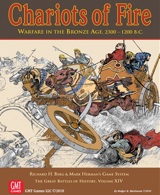Chariots of Fire: Warfare in the Bronze Age – Boardgame Review
 Chariots of Fire: Warfare in the Bronze Age, 2300 – 1200 B. C. Number 14 of the Great Battles of History series. GMT Games. $70.00.
Chariots of Fire: Warfare in the Bronze Age, 2300 – 1200 B. C. Number 14 of the Great Battles of History series. GMT Games. $70.00.
PASSED INSPECTION: Well thought-out game based on a time period for which there is not much of a historical record to go by. Excellent graphics on maps and playing counters.
FAILED BASIC: Digesting the rules and charts takes some time (GMT Games rates CoF as a "6" on their complexity scale). Ziplock bags provided to store the counters aren’t large enough to hold the Egyptians or the game markers.
All infantry units can fire forward or into the flank areas of their facing, while chariots have a full 360-degree arc of fire
Chariots of Fire starts players out with two simple and balanced armies on a plain desert battlefield-the Battle of Sumer (ca. 2320)-and then builds from there to the Battle of Troy (ca.1200). And, yes, there are counters for several of the heroes and villains of antiquity. It is a great game for up to four players or for solitaire play and it offers an unlimited number of "what if" possibilities. For example: although there no pieces for the Hebrew forces from the Old Testament, by using the Barbarian Infantry of the Danaans forces and playing against the Hittites or Canaan forces in rough terrain without chariots, you can have some interesting but historical battles as will.
{default}The 5 maps (two are double sided) are designed for the battles of Sumer 2320 BCE, Senzar 1470 BCE, Astarpa River 1312 BCE, Nihriya 1230 BCE, Babylon 1225 BCE, Kadesh 1300 BCE, Sekmem 1875 BCE, Megiddo 1479 BCE and Troy 1200 BCE. They are hex grid with each hex representing about 100 yards across. The 840 counters are mostly chariots or infantry or are markers for leaders, damage and the like. Nationalities represented include Egyptians, Hittites, Mitanni, Canaan, Assyria, Kassites, Arzawa, Danaans, and Trojans.
At the beginning of a turn, roll the die and add your leader’s initiative to see who moves first. There is one activation marker for each wing or division of both armies, plus one momentum marker. At the start of a turn the player who won the initiative gets to select which one of his markers he wishes to use while all the others are placed in a cup for a random draw; a wing or division acts when its marker is drawn, regardless of which player drew that marker. When the momentum marker is drawn, the player who drew it gets to choose any wing or division and activate it then instead of waiting to draw its marker; if that wing or division has already performed an action this turn, the player can use the momentum marker to give it a second action.
After moving, resolve all missile fire (bows, javelin and slings), then resolve hand-to-hand combat. In hand-to-hand, once two enemy units come into contact players have to decide which unit attacks first, in what is called the "Shock Combat Segment." First determine who must Shock and who may do so. Perform a pre-shock troop quality check to see if you unit stands and fights or if it runs away for being out-speared, out-bowed, out-javelined, or out-slinged. Resolve possible leader casualties, including mandatory Heroic Combat-yes, there are hero counters for several historical or legendary heroes, including Hector and Achilles!
Resolve the shock effects and check for possible collapse or rout of your forces. At this point replace "killed" leaders, reload missile supply (bows, javelins and slings) and remove all the game markers for the next turn.
When placing and moving combat units the hex lines must be flush along their sides. This will always give units two clearly defined front, flank and rear hexes for determining such things as line of sight for combat and control. All infantry units can fire forward or into the flank areas of their facing, while chariots have a full 360-degree arc of fire. Missile range can be up to three hexes, depending on weapon type. Infantry and battlewagons are not allowed to enter an enemy-held hex; however, chariots may pass through such hexes. There is an optional rule for possible chariots turnover. Stacking is limited to a leader, information markers and "Runner" infantry.
Play continues until one side wins, or players can choose to play for a set number of turns. At the end of the game, if your forces get to go home and were not beaten too badly, ah, what the heck, go ahead and claim victory-even if you lost the game! My research says that as long as the enemy did not take your city and left your country you could declare that you won. Of course, when the enemy got home, they also claimed victory to justify the campaign expense.
The designers put a lot of research into this game, but where there was a lack of historical documentation they had to fill in with just plain old common sense! Once I got an understanding of the rules I found the game to be very enjoyable. I love the graphics of both the maps and counters. Chariots of Fire is a game that I will gladly recommend to anyone.
About the Author:
Bob Gunter is a retired Air Force veteran who started playing Avalon Hill games in the middle 60s and given the chance will go toe-to-toe with anyone in a game. He enjoys writing, researching genealogy and history and is a student of anthropology, paleontology and historical theology.







